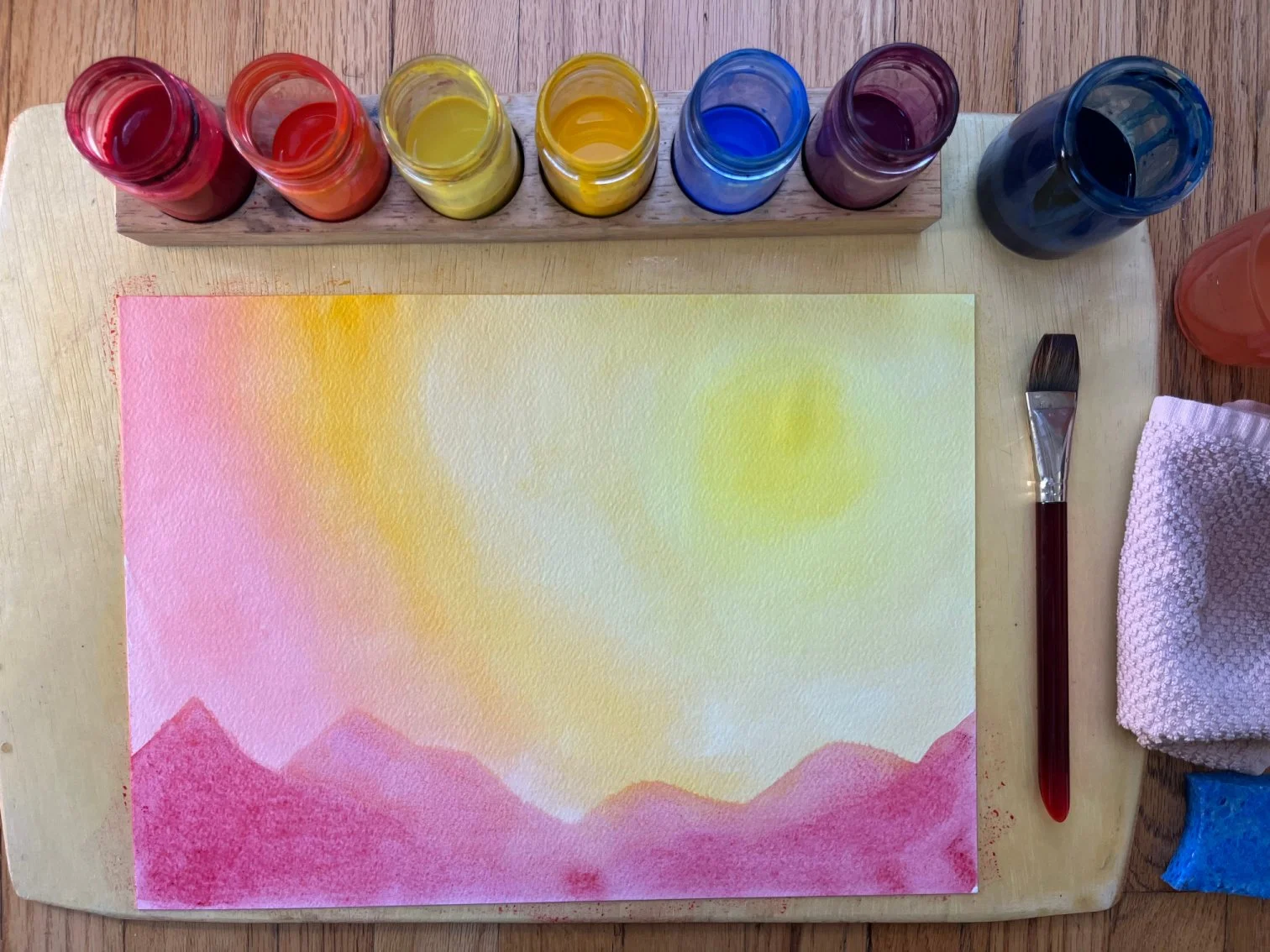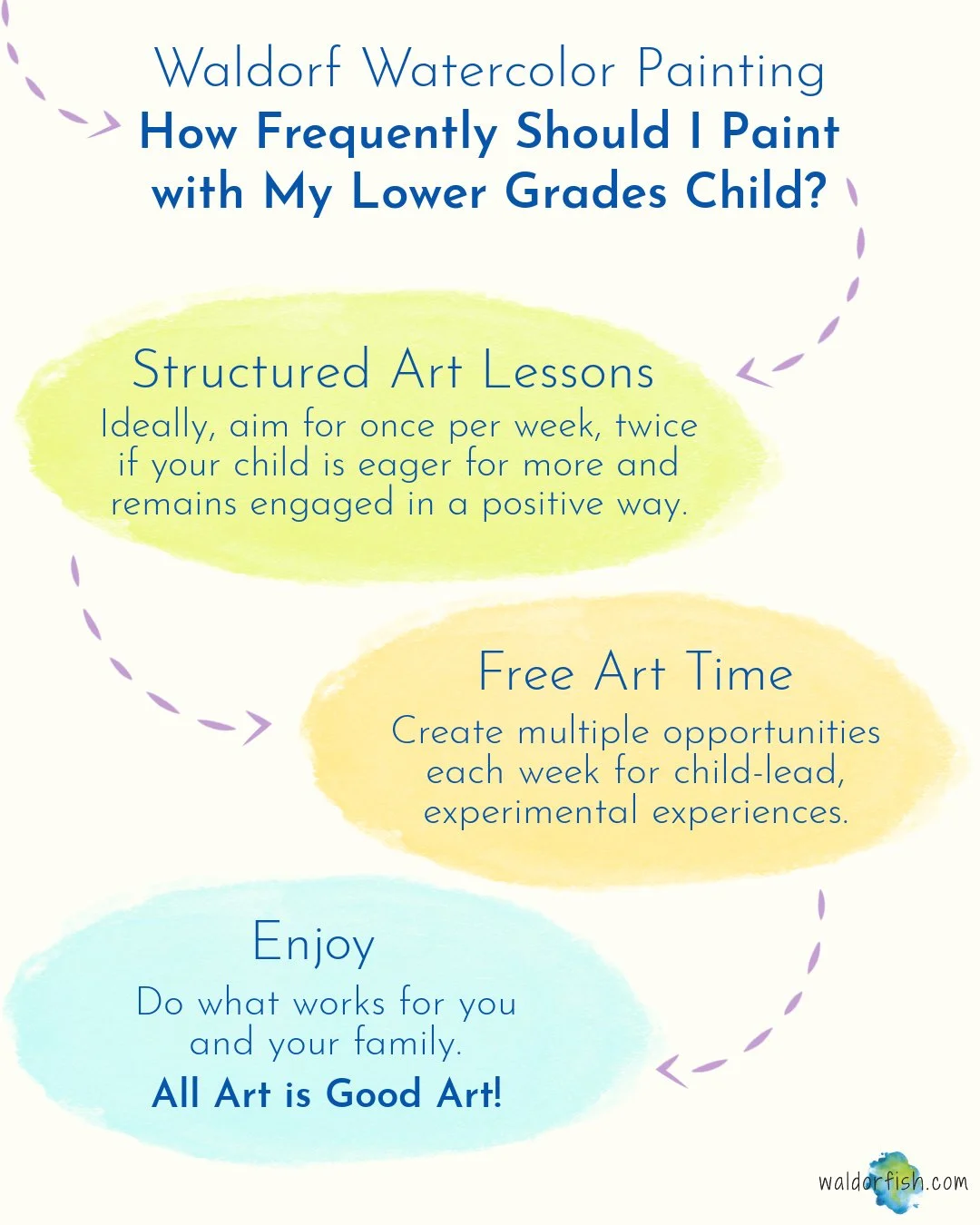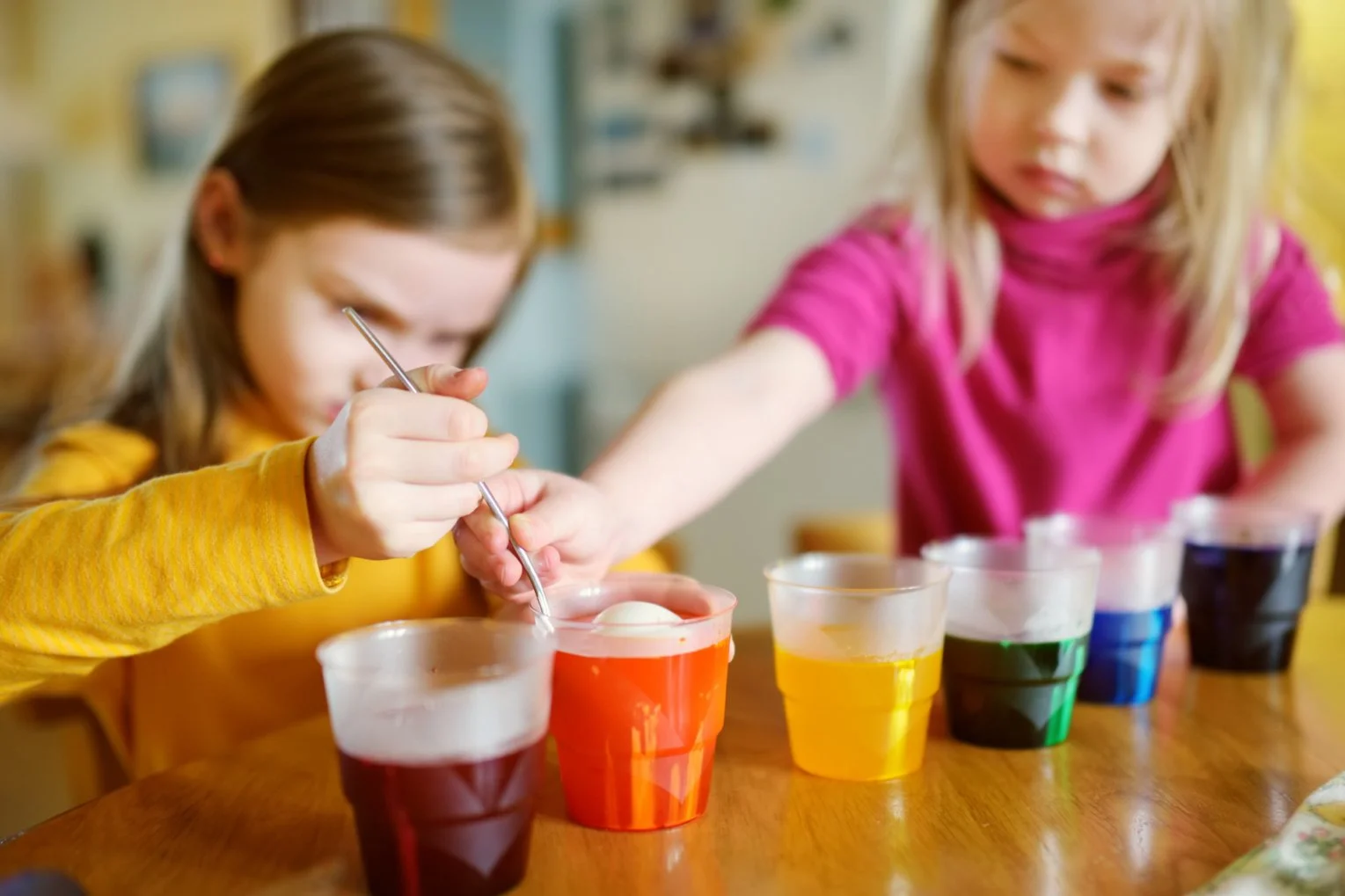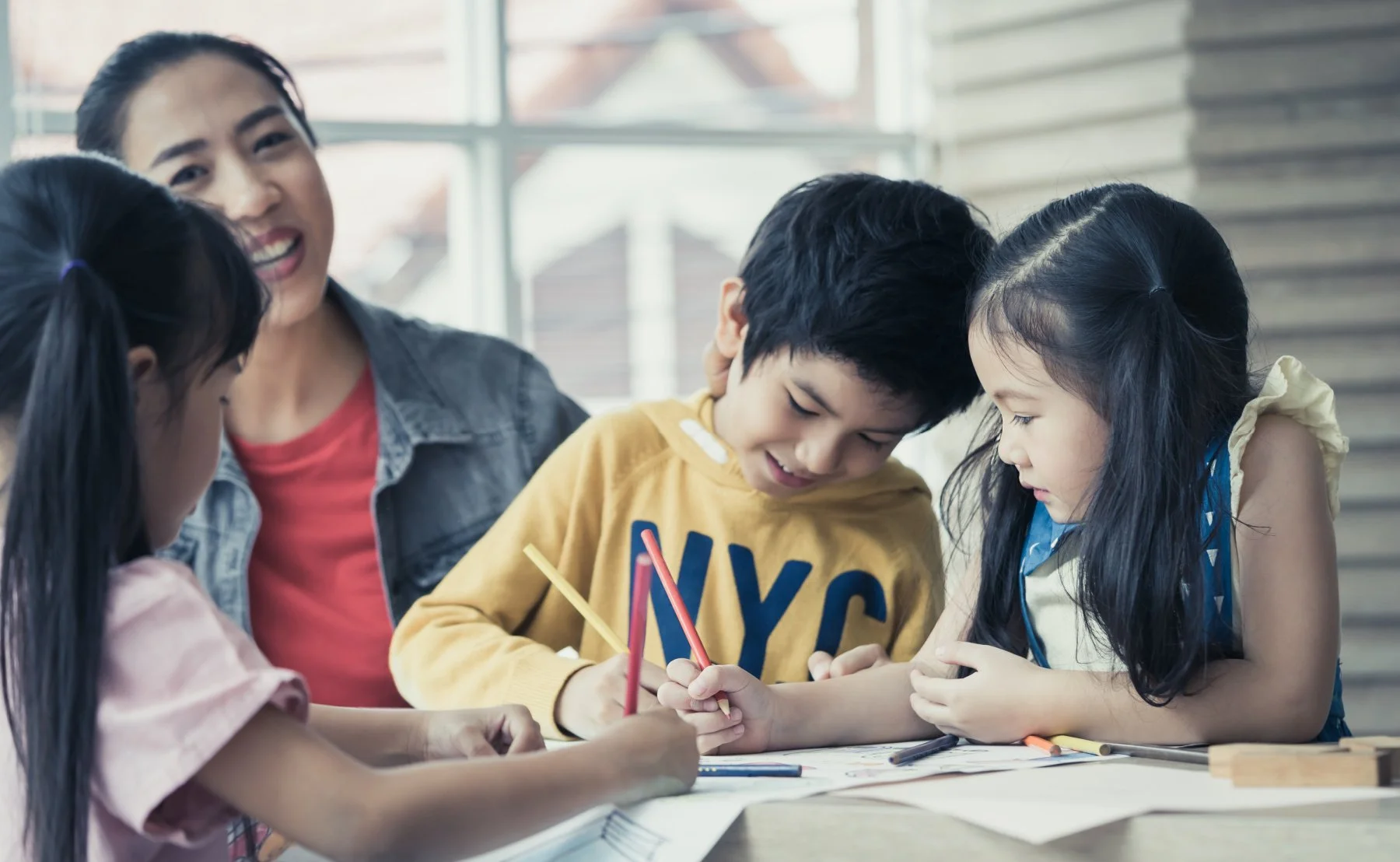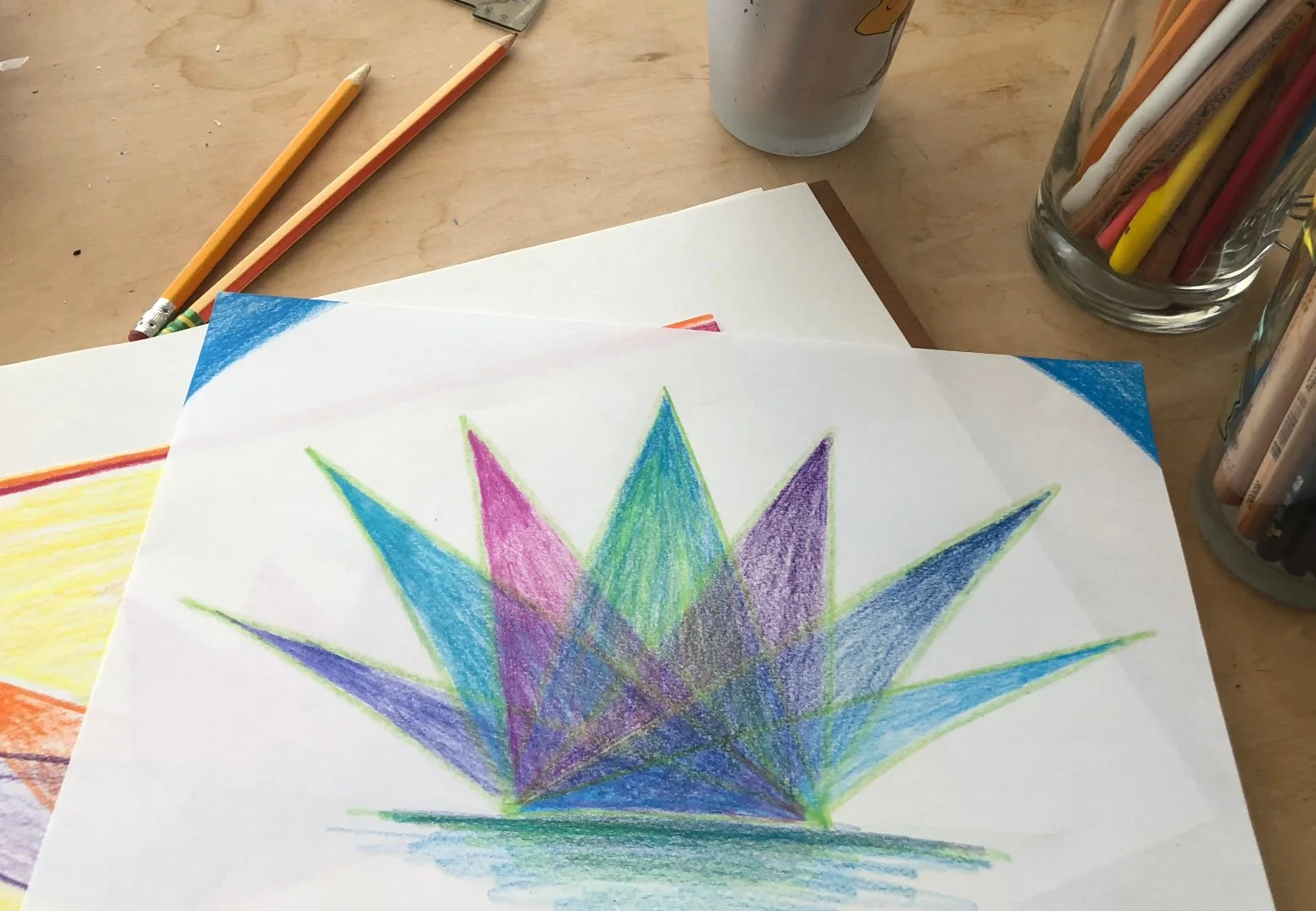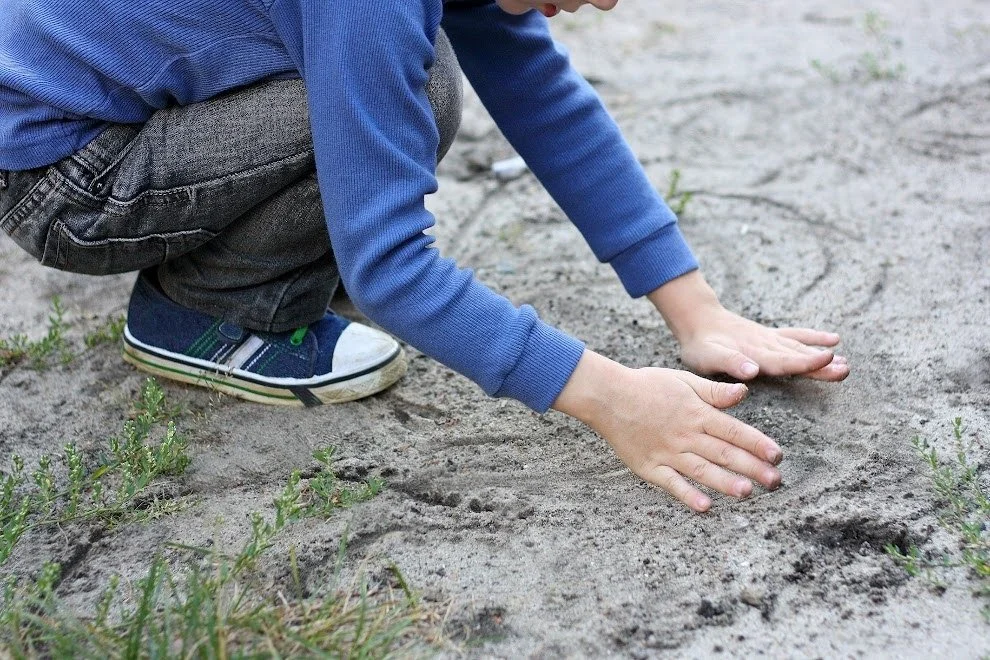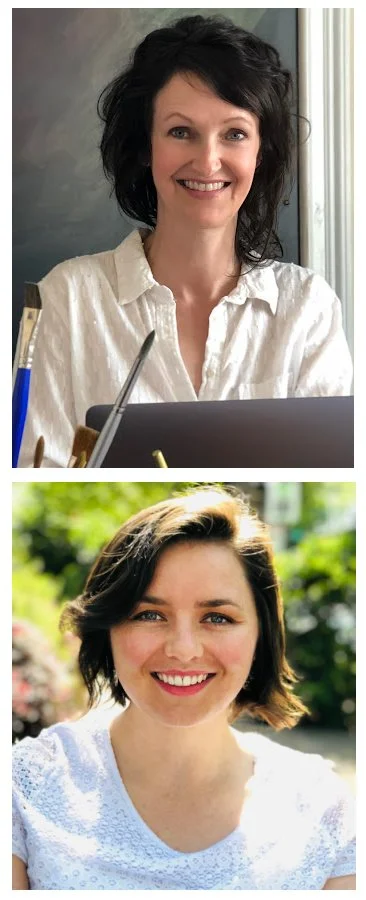
Waldorfish Blog
Waldorf Painting Curriculum FAQ’s: How Often Should I Paint with My Lower Grades Child?
Watercolor painting is a staple of Waldorf curriculum, especially in the lower grades (1-4).
A painting from our third grade painting course- a great option for “structured art” time!
First grade paintings are done with one to two colors, and the child is encouraged to build a relationship with color through experience and connection. From there, the second grader finds form in their painting, and the third grade combines color with form for all the more complex and beautiful works of art. As students grow older, paintings grow in their intricacy and subject matter, and are always connected to nature, the seasons, and the curriculum.
A question that often comes through our inbox, especially from homeschooling families, is: How often should I paint with my lower grades child?
This is a great question! From our years of experience in working with students in the classroom and in the homeschool space, we've learned that there are great benefits to two different approaches: structured art time and free art time.
Watercolor painting, when done with a Waldorf approach, falls into the “structured art” category.
The painting activity comes with a fully formed lesson. The adult educator sets up the space, may choose to utilize a verse and set a mood of reverence, and paints alongside the child, leading them through the process from start to finish. It is a time where the educator is truly the captain of the ship, and the children have the opportunity to immerse themselves in the guided experience.
Ideally, we suggest doing structured art time once a week, or more, if you feel your child remains positively engaged with the lessons! In this case, less can really feel like more.
The second category of “free art time” creates opportunities where the child is leading the way.
They can experiment with all kinds of supplies, and work without much guidance- it's their time to create, play, and try new things. Watercolor painting can certainly be a part of this activity as well! Here, the educator is the host, making sure everyone has what they need to create safely, freely, and with joy.
Free art time can be a time of creativity and experimentation!
Free art time can be a part of a rhythm in whatever way works best for the student and the educator. Once a week, twice a week, everyday- as long as the student is engaged during the free art time, it’s a great time for art!
Lastly, and perhaps most importantly, we are big proponents of the idea that all art is good art!
There are many approaches to teaching watercolor painting and other art mediums, and sometimes it can feel overwhelming to get it “right.” We encourage you to dive in, try it out, and adjust from there. Bringing art into your rhythm should feel doable and meaningful, and however that works best for you and your children is the way to go.
Enjoy!
About the Authors
Robyn Beaufoy is Waldorfish’s CEO, and also a course instructor for Simple Season,, Waldorf Art for Beginners, and Weekly Art Foundations. You’ll find her intuitive touches and influences throughout everything Waldorfish offers. Robyn has been in the world of education for over 25 years, with an MA in Education and a certification in Waldorf teaching - she also homeschooled both of her children for some of that time. In 2012 Robyn co-founded Waldorfish.com, creating it with the vision of making Waldorf inspired-art and pedagogy more accessible, joyful, and doable for homeschoolers all over the world.
Caitlin Amajor is Waldorfish’s course instructor for Geometry grades 5 & 6, and Botany, as well as our Administrative Assistant. From a young age, Caitlin has been immersed in Waldorf education, attending a Waldorf school from K-8. After receiving a BA in History, Caitlin gained her certification in Waldorf teaching, and spent seven years as a Waldorf class teacher in the upper grades. With a special fondness for watercolor painting and geometry, Caitlin loves bringing Waldorf education to her students all over the world, and seeing their own individuality and style bloom from the curriculum!
What is Waldorf First Grade Curriculum for Art?
Q: What is the Waldorf first grade art curriculum?
(This post is part of a series in which we answer the most common questions we receive in our inbox re: homeschooling, Waldorf curriculum/pedagogy, and whatever else comes our way! Click here to read more from the series!)
A: If you’re just getting started with your homeschooling journey, you’re probably thinking about how you’ll bring the Waldorf first grade art curriculum into your rhythm.
We’ve put together this piece as a starting place for you - we’ll be answering frequently asked questions about Waldorf art in first grade, and providing you some helpful resources to help make your artistic journey doable, meaningful, and fun!
What does the Waldorf art curriculum include in first grade?
In Waldorf education, first grade is a pivotal milestone in a child AND educator’s educational and developmental journey. Amongst the newness of the grade (from academics, to daily routine, to social dynamics) art is incorporated into nearly every aspect of the curriculum (to learn more about the role of art in education across all the grades in Waldorf curriculum, click here!)
Each family and school will vary their art curriculum, but generally, a first grader will enjoy experiences with wet-on-wet watercolor painting, form drawing, pencil and crayon drawing, and the joy of learning through storytelling.
How is chalk art used in first grade?
In Waldorf first grade classrooms, chalk art is a tool used by the educator to enliven and enhance the curriculum through pictures. The drawings change frequently, and usually relate to the subject being studied or the season at hand.
The letter “G” for goose- all in one image!
In a first grade classroom, one might observe the drawing of a goose combined with the image of a letter G (see an example to the right!) and the story of the day may be the fairy tale of the golden goose. Together, the image and the story work to enliven the language arts lesson for the children as they get to know the letter G!
At this point, chalk drawing is a medium generally used only by the educator, and one that provides endless possibilities in bringing the curriculum to life on the chalkboard. To learn more about chalk drawing and the role it plays in Waldorf education, click here.
How is Waldorf watercolor painting introduced in first grade?
A particular style of watercolor painting, often referred to as wet-on-wet painting, is practiced throughout the grades in Waldorf schools, though most often in the lower grades, 1-4. This technique of painting involves using liquid watercolor pigments on damp paper. The resulting effect is paintings that are saturated in color and unique to each artist.
Watercolor paintings from our first grade course- each is different and unique!
In grade one, the lessons are simple color experiences guided by the teacher. It is purely artistic work - there is no expectation of the children creating a specific form or picture of something. Colors are introduced slowly and individually, giving the children plenty of time to enjoy and experience the color inwardly and deeply. To learn more about the pedagogical foundations of Waldorf first grade watercolor painting, click here.
What is form drawing?
Form drawing is a practice which allows children (and adults!) to engage with space, balance, and symmetry through drawing. In first grade, form drawing starts with simple basics, as we are just introducing the child to the world around them. Form drawing also provides foundational exercises that support handwriting, pencil grip, and much more.
You’ll often see the children’s exploration of straight and curved lines hanging on the walls in Waldorf first grade classrooms. The children are guided through the practice of drawing straight and curved lines on the chalkboard, paper, in sand, even in the mud, etc. Building in a variety of layers of experience helps the child's body internalize the movements more deeply.
Though it may seem simple, what the first grade begins to discover is that straight and curved lines are in everything, building connections with their environment and natural world around them. To learn more about first grade form drawing, click here.
Form drawing can be done inside, outside, or wherever inspiration strikes!
How do I incorporate form drawing into the first grade?
Form drawing is best done as a regular practice in a child’s daily rhythm. Shorter, but regular sessions truly allow the various forms (and the process to create them!) an opportunity to deeply integrate into the child’s body and soul.
To really make something a part of your daily practice (ten to fifteen minutes per day is ideal!), put it on the calendar, follow through, and be intentional. Soon, the routine will become second nature, and you will truly reap the benefits that rhythm provides. (To learn more about Waldorf form drawing, click here!)
What is the significance of storytelling in Waldorf education?
Storytelling is an important tool in Waldorf education, especially in the lower grades! The Waldorf curriculum is rich in story, from nature stories and fairy tales, form drawing stories, through great myths and legends, to biographies and historical stories.
Oftentimes, stories are told orally, or without the use of a book or notes. It’s a way of connecting with the child, storyteller to listener, and allowing the content to come alive in a rich and organic way. When we don’t rely on the written word, the storyteller is able to tailor the story to the needs of the child. Though you may not know it, you already are a storyteller – you can get started right away with bringing stories into your regular routine! Click here to learn more!
How do I get started with Waldorf art?
First and foremost- get your supplies in order!
One of the early hurdles of getting started with Waldorf art is the question of supplies- what to buy, where to buy it, how much to spend, and how to use and care for everything! It’s easy to get caught up in buying the art supplies you think you should purchase (while spending a lot of money!) and then leaving it to collect dust on the shelf for fear of wasting it, using it incorrectly, or just not knowing how to use it.
Sound familiar?
So, start at the beginning, and get the support and resources you need right away! Our Waldorf Art for Beginners course was designed to walk you through the most commonly found artistic mediums in Waldorf education, including watercolor painting, crayon, and chalk drawing. This includes what to buy (and what not to buy!) how to care and store for everything, and then, how to use the supplies to create beautiful artwork.
Wanting to make Waldorf art a part of your weekly routine? Our Weekly Art Foundations course provides weekly lessons (enough for an entire school year!) that provides step-by-step instruction using Waldorf art techniques.
Use your resources! Head to our blog post Starting Waldorf First Grade to find all of our resources on art, storytelling, Waldorf pedagogy, and more.
Whew! Ok, it’s time to jump in and explore
Questions? You can connect with us here - we’re happy to help.
About the Authors
Robyn Beaufoy is Waldorfish’s CEO, and a course instructor for two of our courses - Waldorf Art for Beginners and Weekly Art Foundations. You’ll find her intuitive touches and influences throughout everything Waldorfish offers! Robyn has been in the world of education for almost 30 years, with an MA in Education and a certification in Waldorf teaching - she also homeschooled both of her children. In 2012 Robyn co-founded Waldorfish.com, creating it with the vision of making Waldorf inspired-art and pedagogy more accessible, joyful, and doable to homeschoolers all over the world.
Caitlin Amajor is Waldorfish’s course instructor for Geometry grades 5 & 6, and Botany, as well as our Administrative Assistant. From a young age, Caitlin has been immersed in Waldorf education, attending a Waldorf school from K-8. After receiving a BA in History, Caitlin gained her certification in Waldorf teaching, and spent seven years as a Waldorf class teacher in the upper grades. With a special fondness for watercolor painting and geometry, Caitlin loves bringing Waldorf education to her students all over the world, and seeing their own individuality and style bloom from the curriculum!
Why are verses spoken at the beginning of Waldorf painting lessons?
Q: Why are verses spoken at the beginning of Waldorf painting lessons?
(This post is part of a series in which we answer the most common questions we receive in our inbox re: homeschooling, Waldorf curriculum/pedagogy, and whatever else comes our way! Click here to read part one!)
A: Verses are used as a tool in painting class for a few different reasons.
In general, any lesson benefits from structure, and painting class is no different. In Waldorf education, we strive for classes to have a feeling of a beginning, middle, and conclusion.
Beginning with a verse sets a mood, and is a clear indication to the child or class that it is time to focus, and set their intention on the task at hand.
Speaking a verse together also provides an opportunity for the educator to observe where the children or child are at that moment. Are they fidgety? Talkative? Attentive? If the mood is set, the lesson can begin, or the educator can utilize the verse as a tool for classroom management.
This beautiful piece can be found in our third grade painting course- where stories and color come alive through the experience of painting!
For instance, if the children are not quite centered, the verse can be spoken again to bring the group to the space of readiness. Or, a verse can be used to create a space of quiet and stillness through saying it in a whisper, mouthing the words with no sound at all, or making small finger gestures to represent the words in silence.
Through small, creative adjustments, a verse is a wonderful way to bring the children into the meditative space one hopes for in painting class.
Lastly, it is always worth bringing beautiful language into a child’s everyday rhythm. Verses do not have to be long, wordy, or difficult to memorize- even a few lines of meaningful text will go a long way in setting the peaceful, reverent mood one strives for in Waldorf watercolor painting.
About the Authors
Robyn Beaufoy is Waldorfish’s CEO, and also a course instructor for Simple Season (coming soon!), Waldorf Art for Beginners, and Weekly Art Foundations. You’ll find her intuitive touches and influences throughout everything Waldorfish offers! Robyn has been in the world of education for over 25 years, with an MA in Education and a certification in Waldorf teaching - she also homeschooled both of her children for some of that time. In 2012 Robyn co-founded Waldorfish.com, creating it with the vision of making Waldorf inspired-art and pedagogy more accessible, joyful, and doable for homeschoolers all over the world.
Caitlin Amajor is Waldorfish’s course instructor for Geometry grades 5 & 6, and Botany, as well as our Administrative Assistant. From a young age, Caitlin has been immersed in Waldorf education, attending a Waldorf school from K-8. After receiving a BA in History, Caitlin gained her certification in Waldorf teaching, and spent seven years as a Waldorf class teacher in the upper grades. With a special fondness for watercolor painting and geometry, Caitlin loves bringing Waldorf education to her students all over the world, and seeing their own individuality and style bloom from the curriculum!
Waldorf Grade Three Painting: Growing in Color
In Waldorf education, the third grade curriculum includes studying agriculture, shelters around the world, ancient creation stories, and more.
Third grade painting curriculum includes form, color, and beauty!
Through explorations of agriculture and house-building, the children are literally brought down to earth as they carry out practical farming and building activities. In painting lessons, we begin to see more forms and detail than ever before: wheat stalks, log cabins, or a knight overcoming a dragon. Why this shift towards detail and realism in the painting curriculum? Because as educators, it is our task to support the third grade child as they orient themselves in the world.
In the lower grades and in early childhood, children have a deep connection and relationship to the world and people around them. But as they grow into third grade, their independence and individualism begins to bud. Children begin to feel more separate from their friends and family (an appropriate shift at this stage!), they begin to notice some of the challenges and injustices in the world around them, and overall, the world is suddenly new and a bit unfamiliar.
Stories come to life through the watercolor curriculum.
As we can imagine (or maybe even remember) this is not an easy place for a child to be in their development.
It can feel uncomfortable, exciting, or uncertain. As educators, our task is to strive to communicate this overall theme: human beings have lived, thrived, and overcome. Humans have figured out how to make homes and live in community, wherever they may be, with whatever resources they may have. Even through the greatest of challenges and obstacles, humans find a way to persevere.
In Waldorf education, the painting curriculum is designed to meet the growing child right where they are.
The activity of painting mirrors what the children are also exploring in other parts of the curriculum: how human beings live in the world in all different places, circumstances, and challenges.
The third grade shelter curriculum melds perfectly into watercolor painting class.
Painting shelters is not simply painting a structure, but includes observing and appreciating the beauty of the surrounding natural landscape. A log cabin comes to life on the page through the shady forest; an adobe home emerges from the warm and arid desert landscape; snow houses appear through an icy blue snowstorm.
To deepen their studies of farming, the children paint wheat stalks ready for milling, apples ready for picking, and carrots pulled from the carefully tilled earth.
After immersing themselves in ancient creation stories, the children’s paintings of rainbows are not just a combination of colors, but the representation of humanity surviving a storm, and their celebration of all the beauty and potential the world has to offer.
Third grade is a new kind of school year for the child: the world is something new and unfamiliar, and through the painting curriculum, the educator can support their journey in bringing the beauty of the earth, its resources, and the resilience of the human spirit to life!
About the Author
Amanda Ziadeh Mercer is a dynamic Waldorf Teacher! She has had the pleasure of working with children in varying stages of development, ranging from infants in Parent-Child programs to the more mature students of the eighth grade. This wide range of experiences has gifted her a full picture of the developmental stages of childhood.
MORE FROM WALDORFISH CONTRIBUTORS AND TEACHERS:
Looking for something?
Welcome to Waldorfish! We started this adventure in 2012 out of a desire to make Waldorf training more accessible to class teachers in remote locations and to homeschooling families everywhere! Read more, click here.
WE WON! Our Weekly Art courses were voted “best interactive art program.” Learn more about the award, here.
A few of our most popular blog posts:

